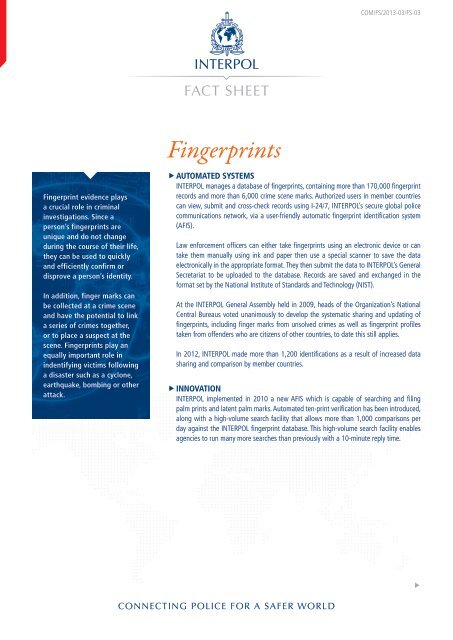Fingerprints - Interpol
Fingerprints - Interpol
Fingerprints - Interpol
Create successful ePaper yourself
Turn your PDF publications into a flip-book with our unique Google optimized e-Paper software.
COM/FS/2013-03/FS-03<br />
FACT SHEET<br />
Fingerprint evidence plays<br />
a crucial role in criminal<br />
investigations. Since a<br />
person’s fingerprints are<br />
unique and do not change<br />
during the course of their life,<br />
they can be used to quickly<br />
and efficiently confirm or<br />
disprove a person’s identity.<br />
In addition, finger marks can<br />
be collected at a crime scene<br />
and have the potential to link<br />
a series of crimes together,<br />
or to place a suspect at the<br />
scene. <strong>Fingerprints</strong> play an<br />
equally important role in<br />
indentifying victims following<br />
a disaster such as a cyclone,<br />
earthquake, bombing or other<br />
attack.<br />
<strong>Fingerprints</strong><br />
ffAutomated systems<br />
INTERPOL manages a database of fingerprints, containing more than 170,000 fingerprint<br />
records and more than 6,000 crime scene marks. Authorized users in member countries<br />
can view, submit and cross-check records using I-24/7, INTERPOL’s secure global police<br />
communications network, via a user-friendly automatic fingerprint identification system<br />
(AFIS).<br />
Law enforcement officers can either take fingerprints using an electronic device or can<br />
take them manually using ink and paper then use a special scanner to save the data<br />
electronically in the appropriate format. They then submit the data to INTERPOL’s General<br />
Secretariat to be uploaded to the database. Records are saved and exchanged in the<br />
format set by the National Institute of Standards and Technology (NIST).<br />
At the INTERPOL General Assembly held in 2009, heads of the Organization’s National<br />
Central Bureaus voted unanimously to develop the systematic sharing and updating of<br />
fingerprints, including finger marks from unsolved crimes as well as fingerprint profiles<br />
taken from offenders who are citizens of other countries, to date this still applies.<br />
In 2012, INTERPOL made more than 1,200 identifications as a result of increased data<br />
sharing and comparison by member countries.<br />
f f Innovation<br />
INTERPOL implemented in 2010 a new AFIS which is capable of searching and filing<br />
palm prints and latent palm marks. Automated ten-print verification has been introduced,<br />
along with a high-volume search facility that allows more than 1,000 comparisons per<br />
day against the INTERPOL fingerprint database. This high-volume search facility enables<br />
agencies to run many more searches than previously with a 10-minute reply time.<br />
<br />
CONNECTING POLICE FOR A SAFER WORLD
<strong>Fingerprints</strong><br />
ffSharing best practice<br />
An International Fingerprint Symposium takes place every two years. Attended by the<br />
Heads of National Fingerprint Bureaus, INTERPOL representatives and private companies,<br />
it provides an opportunity for experts from around the world to share best practice and<br />
latest developments.<br />
In addition to the Symposium, INTERPOL organizes an AFIS experts’ working group. This<br />
takes place twice a year and is a forum for discussing new technology, identification<br />
procedures and training needs, and for ensuring that INTERPOL’s systems comply with the<br />
necessary standards.<br />
ff<br />
Contact information:<br />
Contact us via our web site. For matters<br />
relating to specific crime cases, please<br />
contact your local police or the INTERPOL<br />
National Central Bureau in your country.<br />
ff<br />
Twitter: @INTERPOL_HQ<br />
ff<br />
YouTube: INTERPOLHQ<br />
ff<br />
www.interpol.int














